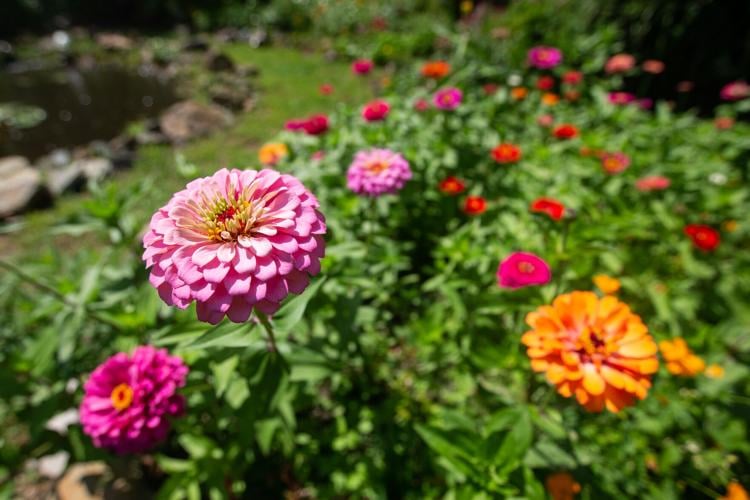HUNTINGTON �����Ƶ� Birds, butterflies and bees rely on native plants as they migrate and live in the same ecosystem as people.
�����Ƶ�Our pollinators, they really need our help right now. Monarch butterflies have recently been added to the endangered species list. And I know a lot of people are like, they�����Ƶ�re bees and butterflies, why do we care? But they pollinate all of our food, and so without these pollinators, we will not have food,�����Ƶ� said Amy Parsons-White, director of the sustainability department at Marshall University.
People need to make sure pollinators have all the food they need in order to do their jobs, Parsons-White continued. There are ways to make your outdoor space more welcoming to them.
Number one is adding native plants, which will be easier to grow and are eco-friendly.
�����Ƶ�Native plants are going to thrive here, and they�����Ƶ�re going to not interfere with our local wildlife. They�����Ƶ�ll attract birds, butterflies, everything that you want to see in your backyard, if you choose natives. They�����Ƶ�ll also be more resilient as far as our local climate, so drought resistant. They�����Ƶ�ll be more resistant to local pests and disease and that kind of thing, if you choose local. So you�����Ƶ�ll end up saving a lot of money by choosing native plants,�����Ƶ� Parsons-White said.
For butterflies specifically, she recommends planting milkweed. According to the West Virginia Department of Natural Resources, West Virginia is home to 13 species of milkweed. She says the West Virginia Native Plant Society is also a great resource for finding native plants to cultivate.
and are companies that specialize in wildflower seeds and more sustainable lawns.
Tabar Gifford, the customer experience and partnership cultivator at American Meadows and High Country Gardens, is a Master Gardener and dedicated �����Ƶ�plant geek.�����Ƶ� Gifford suggests first thinking about your outdoor space as part of the larger ecosystem: Start by evaluating your yard and considering how you can support local pollinators, birds and beneficial insects.
�����Ƶ�One of the easiest and most impactful changes is reducing or eliminating chemical pesticides and herbicides. These can harm pollinators and beneficial insects that help maintain a healthy ecosystem,�����Ƶ� Gifford said. �����Ƶ�When prepping your yard for summer, focus on adding diverse native plants that bloom throughout the season to provide food and shelter. If you currently have a traditional lawn, consider replacing part of it with native plants or wildflowers to support biodiversity.�����Ƶ�
With a lifelong love for gardening and nature, and a background in environmental studies and sustainable community development, she combines horticultural expertise with a commitment to education. She has some recommendations for Huntington specifically.
�����Ƶ�Huntington�����Ƶ�s climate supports a wide range of native plants, making it a great place to establish an eco-friendly garden. The Ohio River Valley area is known for its rich soil, so native wildflowers and meadow plants thrive here,�����Ƶ� she said. �����Ƶ�Incorporating rain gardens can help manage heavy seasonal rains while providing habitat for pollinators.�����Ƶ�
Homeowners can use drought-tolerant native plants like Coneflowers, Coreopsis and Baptisia to help reduce water usage in the hotter months.
�����Ƶ�Additionally, planting in layers �����Ƶ� with taller shrubs, mid-sized flowers and groundcovers �����Ƶ� can maximize space while providing shelter for pollinators and birds,�����Ƶ� she said.
Her recommended plants for butterflies include Coneflower (Echinacea), Bee Balm (Monarda), Black-Eyed Susan (Rudbeckia) and Liatris.
For hummingbirds, planting flowers with long, tubular blossoms is key, she said. They are most attracted to vivid red, orange, pink and purple flowers, as they find food by sight rather than scent.
Good choices include Coral Bells (Heuchera) and Honeysuckle (Lonicera), Salvia and Hummingbird Trumpet (Zauschneria).
Wildflowers and bulbs like Zinnias, Mexican Sunflowers, Crocosmia, Gladiolus, and Cleome are excellent for providing nectar and attracting hummingbirds.
The coveted big, grassy lawn is likely driving wildlife away.
�����Ƶ�A great alternative is planting a clover lawn or a native groundcover mix instead of traditional turfgrass,�����Ƶ� Gifford said. �����Ƶ�White clover, micro-clover, and creeping thyme stay green, require little mowing, and provide nectar for pollinators. Some native grass alternatives like Buffalo Grass or Fine Fescue grow slowly and require minimal maintenance.�����Ƶ�
The American Meadows is May 20. It encourages people to replace underutilized turf areas with pollinator-friendly plants, native flowers and edible gardens.
Parsons-White also says a ground cover alternative is ideal; but for people who just can�����Ƶ�t bring themself to get rid of grass, she has a tip:
�����Ƶ�I think that a lot of people mow their grass too often, and it�����Ƶ�s actually better for your soil and the grass if you mow it less often,�����Ƶ� she said. �����Ƶ�So if you�����Ƶ�re just completely stuck on grass or you just like the look of it for your lawn, let your grass grow 2 to 3 inches high. Maybe only cut it once a week or once every other week.�����Ƶ�










